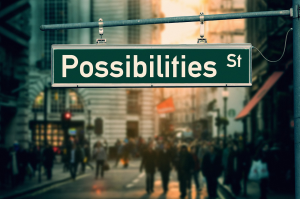
The description for the Community Partnerships class that I teach for the iSchool reads:
Public libraries are no longer your mother’s public libraries. Facing cuts in funding yet increasing use, the landscape has changed dramatically in recent years. Public libraries have expanded focus to include more programming and extending reach beyond the four walls of a physical space. Partners benefit by getting their message or education out to a huge population – the library’s patron base and in turn, libraries benefit by having new avenues in which to attract patrons and expose new people to all that a public library can provide for them. Students will examine what makes up a community partnership, work to identify possible partners, and study some real, unique, and successful community partnerships in depth.
Community partnerships aren’t the future, they are now. What seems intuitive to me isn’t necessarily so for those currently studying to be librarians. To some extent, the library is still seen as a place just for books and programming consists of a librarian thinking of a good idea and hoping people come. As championed by The Harwood Institute, it’s time for public libraries to turn outward. This, in part, means looking to your community and asking them what they want to see in the library, what is the community need that the library can help address?
 Partnering with local organizations is a natural step for libraries to take in becoming vibrant assets to their communities. What does a community partnership look like? It can be something on the small side, like inviting your Chamber of Commerce to present to small business owners if your community is entrepreneurial and populated with start-ups. Believe me, a good relationship with your Chamber of Commerce will always benefit the library. In the same vein, if you want to support local businesses, create a program in which patrons can show their library card to receive discounts with your partners. You’ll be encouraging people to get library cards to take advantage of the deals, and participants will see increased business. Win-win. Or perhaps 40% of the incoming class at your local community college can’t pass eighth grade English? Send your graphic-novel expert librarian or assistant out to work with the teachers by advocating for the use of graphic novels as excellent tools for low-level literacy adults.
Partnering with local organizations is a natural step for libraries to take in becoming vibrant assets to their communities. What does a community partnership look like? It can be something on the small side, like inviting your Chamber of Commerce to present to small business owners if your community is entrepreneurial and populated with start-ups. Believe me, a good relationship with your Chamber of Commerce will always benefit the library. In the same vein, if you want to support local businesses, create a program in which patrons can show their library card to receive discounts with your partners. You’ll be encouraging people to get library cards to take advantage of the deals, and participants will see increased business. Win-win. Or perhaps 40% of the incoming class at your local community college can’t pass eighth grade English? Send your graphic-novel expert librarian or assistant out to work with the teachers by advocating for the use of graphic novels as excellent tools for low-level literacy adults.
Or you can go huge. Take War Ink, a project that has national, if not international reach. Partners in this project ranged from 20 California library systems to local businesses to several branches of the military. Don’t be intimidated – not everything can be a War Ink. But it is a prime example of how, with the help of partnerships (read: getting outside of the library), libraries can do anything!  Who would have thought an online exhibition of military tattoos aiming to tell the stories of veterans as an attempt to open conversation with the public would come out of a public library? Well, it did.
Who would have thought an online exhibition of military tattoos aiming to tell the stories of veterans as an attempt to open conversation with the public would come out of a public library? Well, it did.
Community partnerships are becoming more ubiquitous. And the best thing about them–all you have to do is ask. People generally want to say yes to libraries. I have found there is a certain level of fear about “the ask” when I teach Community Partnerships, but take it from me: practice makes perfect. And all parties benefit.
Morgan Rose Pershing works in public libraries and teaches two Info 281 Seminars in Contemporary Issues– Community Partnerships and Graphic Novels–both being offered for the Summer 2017 term.
During her time as a librarian, Pershing has served children, teens, adults and seniors and has worked in public, special and academic libraries. She spent eight and a half years as the Adult Services Librarian at Santa Clara City Library, and will begin in January as the Community Library Manager for the County of Los Angeles Public Library (COLAPL) at the Catalina Island branch. She has overseen award-winning grant projects, built an incredibly strong Adult Summer Reading Program, and created a space for artists within the library. Pershing has presented at conferences on many topics, and created webinars for CLA and other state library associations. In addition, she is a Transforming Life after 50 Fellow and a Eureka! Leadership Institute Fellow (2011).
She is an outspoken advocate of all things library, believes adults are people too, collects vintage Ray-Ban Lisbon sunglasses from the 60s and considers avocados to be perfection in nature.
images courtesy of War Ink and Chris Brown, the Santa Clara Public Library and Morgan Pershing

